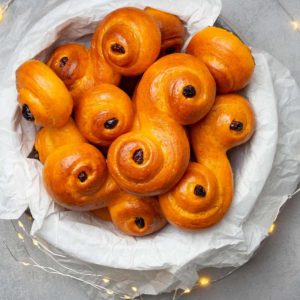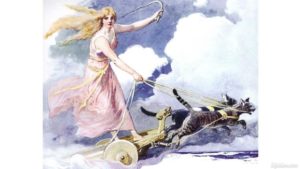
The folklore surrounding December 13th has held a special place in Norway since the Viking Age. It was thought to be the longest night of the year and the beginning of the Yule season. It was a dangerous night, since it was ruled by a female spirit, a vette or vaettir, called Lussi (“Light”). She was the mother or leader of the vettir (spirits) and other Huldrefolk (supernatural beings), and kin to Huldra (forest spirits), the nisse (gnomes), trolls, and even to the Norse gods. Lussi is associated with the Asgardsrei, the Riders from Asgard; the Julereia, the Yule Riders, and the Wild Hunt, who are said to appear on this night. People did not want to be outside when they went past, because folk legends told of people being snatched up and carried away to some faraway place. Other unwary travelers disappeared forever.

Part of Lussi’s spiritual task was to make sure people completed their chores before the Yule season, which was a holy time when people were not supposed to work. If the work didn’t look like it would be done, the household could have gotten some form of punishment from an angry Lussi. Everything had to be done by December 13th, especially spinning, brewing beer and ale, cleaning, taking care of the animals—domestic and wild–threshing, slaughtering, and baking. Special cakes needed to be made. These cakes, called “Lussi-cats” (Lussekatter) are baked with saffron, an imported spice that’s a yellow color, symbolizing gold, light, sun—all associated with both the goddess Freya and Lussi. The cakes are formed like two spirals, and a raisin or other dry fruit would serve to give the impression of cat’s eyes, or sight in the dark. They were also ancient Nordic circular symbols of the sun. It was important to have these cakes ready for Lussi, and they were eaten by everyone in the household. This was also the night when animals would gossip, and talk to one another about how the people treated them in the past year. If someone had mistreated or abused any animal, vengeance would come from Lussi and her retinue of spirits! So the barn and stable had to be clean and comfortable, and the livestock given an extra treat of food, or a Lussibit, so they would give her a favorable report.
Over the centuries, as Christianity became more and more assimilated into Norwegian culture, “Lussi” became “Lucia” a saint whose name also means “light.” The celebration of St. Lucia, and the household or town processions, are now linked with the Winter Solstice, the darkest night of the year. The young woman representing St. Lucia symbolizes the bringer of light to the dark. She wears a candled wreath, which was traditionally worn as a crown decorated with evergreen lingonberry branches. She is accompanied by young girls as her handmaidens, dressed in white and holding candles. The morning of St. Lucia Day the oldest daughter of the household brings her parents and siblings coffee and pastries for breakfast. These saffron-spiced cakes are called St. Lucia Buns, or Lussekatter.

I was trying to imagine Lussi Long-Night and St. Lucia celebrations by my own ancestors in Norway in the 18th and 19th centuries and earlier. Living on farms, they experienced the long dark nights of winter. Pitch darkness can be very scary, and quickly becomes the domain of monsters and evil. The members of the household must kept busy indoors tending the fire, eating, drinking, sewing and telling stories. On the longest night, in her role as light bringer, the eldest daughter might have led a procession from the house to the stabbur (storage house), barn and stable, and around the boundaries of the farmstead to protect it from evil. In earlier times invocations may have been to Freya, a goddess associated with love, warfare, magic, death, gold, and cats. In the last two centuries St. Lucia has held sway, but I can still feel Freya and Lussi in the night.


That was delightful to read. Thanks, cousin!